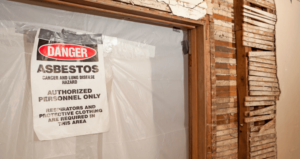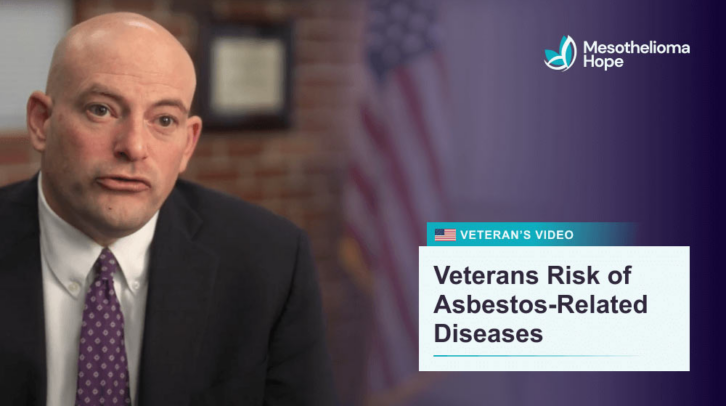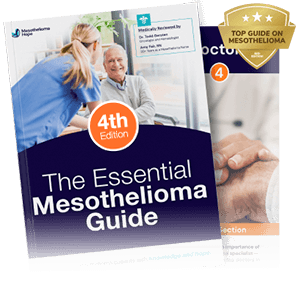Asbestos Exposure and Health Hazards
From the 1930s to the early 1980s, asbestos was one of the most common materials used in the United States.
Asbestos was prominent in many industries due to its natural fire resistance, sound absorption, and insulation properties.

For example, most American buildings constructed during that period contained asbestos-containing materials. In addition to building materials, asbestos was used in many household products like cookware and toothpaste.
Unfortunately, the health effects of asbestos are often devastating. Inhaling stray asbestos fibers can cause various diseases to develop over time.
When stray asbestos fibers are in the air, they can enter the body and get lodged in the lungs and other major body parts. These fibers remain in the body forever once inside and slowly irritate healthy cells until asbestos diseases develop.
There are six types of asbestos, according to the National Cancer Institute (NCI), all of which are dangerous to human health.
More than 90,000 people die each year from diseases caused by occupational asbestos exposure, according to the World Health Organization (WHO).
This is because the general public didn’t know how dangerous the material was — the manufacturers of asbestos-containing products hid the dangers to keep making money.
Today, many innocent people get sick and die from asbestos-related diseases like mesothelioma.
If you or a loved one has an asbestos-related disease, our Patient Advocates can help. They can provide information on the latest mesothelioma treatments and financial assistance to help you pay for them.
Asbestos Disease Groups
There are two main asbestos disease groups:
-
Benign (Non-Cancerous) Diseases
These are abnormal cell growths that don’t spread to other body parts like cancer does. While these diseases — including asbestosis and pleural plaques — can be managed with treatment, they’re rarely curable, and some can even be fatal.
-
Malignant (Cancerous) Diseases
These cancers can be temporarily managed but are usually very aggressive. This category includes lung cancer, mesothelioma, and other cancers.
It’s important to know that not everyone exposed to asbestos fibers will develop an asbestos-related disease. Many factors play into a person’s disease risk, including how much asbestos they were exposed to and how long they were exposed.
Additionally, some people are more genetically predisposed to developing an asbestos disease. Others have lifestyle issues that severely increase risk. For example, smokers have a higher risk of lung cancer or other types of asbestos-related lung disease after exposure than non-smokers.
Veterans are at especially high risk due to the U.S. military’s widespread use of asbestos-containing products to build ships, barracks, vehicles, and other assets from the 1930s to the 1980s.
U.S. veterans who were exposed to asbestos could develop diseases like mesothelioma, asbestosis, and lung cancer decades later. Call (866) 608-8933 to get help after a diagnosis. View Transcript.
Duration: 1 min 01 sec
Veterans who served in the military between the 1930s and the 1980s were likely exposed to asbestos while they were on active duty.
Usually, if you’ve developed an asbestos-related disease, you developed that disease because you had an excessive amount of exposure to asbestos.
If a veteran believes they were exposed to asbestos while serving in the military, we encourage them to call MesotheliomaHope.com so that we can work together to help them file for VA benefits.
The VA will recognize any asbestos-related disease as long as your asbestos exposure happened while you were on active duty in the military.
In addition to VA benefits, MesotheliomaHope.com can connect veterans with world-renowned physicians and nurses on staff that can answer any of your treatment questions. We encourage veterans to call and find out how we can help them.
Benign (Non-Cancerous) Asbestos Related Diseases
The medical definition of a “benign” tumor is a tumor that isn’t cancerous. But, so-called “benign” asbestos diseases are still dangerous to human health. Find a breakdown of each benign asbestos disease below.
Asbestosis
Asbestosis, or diffused pulmonary fibrosis, is a common asbestos disease in which the inner lung tissue gets severely scarred after prolonged exposure to asbestos. This causes pain and severe difficulty in breathing.
When tiny asbestos fibers impale the lung surface, the body’s immune system naturally forms scar tissue to heal these foreign invaders.
Asbestosis is not fatal like cancerous tumors but can lead to respiratory or cardiac failure since the condition worsens over time.
Pleural Plaques
Pleural plaques are calcified forms of collagen (the body’s most common protein). When a foreign substance — such as asbestos fibers — enters a person’s body, a natural immune response may cause pleural plaques to accumulate.
Pleural plaques occur when the membranes of the lungs and the inside of the ribcage thicken, causing a buildup of calcified collagen (plaque). Pleural plaques are usually not dangerous, and often there are no symptoms, according to the British Lung Foundation (BLF).
In rare cases, pleural plaques become widespread and thick. This usually indicates a more serious asbestos-related pleural disease, such as cancer.
Pleural Effusion
Pleural effusion is an excess fluid build-up in the lungs. Pleural effusions occur between pleural layers, such as the lung tissue and mesothelium (the outer layer of the lungs).
According to the Cleveland Clinic, pleural effusions cause symptoms such as a dry cough, difficulty breathing, and chest pain. Doctors can surgically drain pleural effusions to ease these symptoms.
Pleural effusions are often a symptom of pleural mesothelioma.
Other Benign Asbestos Diseases
Although uncommon, several other benign diseases and conditions are associated with asbestos exposure.
Other benign asbestos diseases include:
- Diffuse pleural thickening occurs when scarring thickens the lungs and chest wall lining, according to the British Lung Foundation (BLF).
- According to the Mayo Clinic, Atelectasis is the medical term for a partially deflated or collapsed lung. This condition causes coughing, wheezing, and difficulty breathing.
- Peritoneal ascites or pericardial effusions: Much like pleural effusions, these conditions occur when fluid builds up in the lining of the abdomen or heart, respectively.
- Chronic obstructive pulmonary disease (COPD): This progressive disease causes difficulty breathing and may lead to even worse illnesses like lung cancer, according to the Mayo Clinic. It is often caused by smoking, but inhaling asbestos fibers can also trigger this disease.
There is even an asbestos disease known as clubbed fingers, where fingertips become box-like. This condition is often associated with asbestosis, according to the Mayo Clinic.
Asbestos Related Cancers
The link between asbestos exposure and cancer risk is significant. Malignant (cancerous) diseases caused by asbestos exposure have a limited prognosis for long-term survival.
The best hope for dealing with cancer is catching it early and taking immediate action to remove or destroy the tumors. Unfortunately, malignant asbestos diseases take so long for the symptoms to present that they usually have spread throughout the body, making treatments difficult.
Exactly how asbestos causes cancer is not fully understood by medical science. There is overwhelming proof they do, though.
Asbestos particles are mineral-based. The immune system can’t break them down as organic and biological impurities can be.
Asbestos scarring in a lung or other organ tissue turns cancerous because healthy cells become damaged and their DNA changes. These cells rapidly multiply rather than die and replace themselves. In the process, these rogue cells damage other organs and shut them down, killing the host.
Malignant tumor cells spread or metastasize to other areas. Often, they invade a neighboring organ or travel through the lymphatic system to distant parts of the body, including other major organs like the brain.
To learn more about the cancer malignant mesothelioma, including treatments and doctors, request our Free Mesothelioma Guide.
Lung Cancer
Lung cancer is a common and very dangerous asbestos disease. While other carcinogens like tobacco smoke, radon, and heavy metals are the most likely causes of lung cancer, asbestos exposure accounts for an estimated 20% of all cases.
Lung cancer tumors form in the inner pleural tissue. Left unchecked, this cancer significantly impairs lung function and can be fatal.
Treatment for this asbestos disease includes a combination of surgery, chemotherapy, and radiation.
Mesothelioma
Malignant mesothelioma does not just affect one part of the body. It can appear in several areas and spread widely via the lymph nodes.
There are four types of mesothelioma:
- Pleural mesothelioma: This is the most common type of mesothelioma, developing in the lining of the lungs (the pleura). It can cause pain in the chest, ribs, shoulders, and upper back. Other symptoms include coughing blood, shortness of breath, difficulty breathing, and weight loss.
- Peritoneal mesothelioma: This type of mesothelioma forms in the lining of the abdominal cavity (the peritoneum). Common symptoms include abdominal pain, constipation, swelling due to fluid buildup, nausea, blood in stool (feces), and vomiting. Less common symptoms include pain in the upper back and ribs.
- Pericardial mesothelioma: With this type of mesothelioma, tumors first develop in the heart’s lining (the pericardium). It can cause an irregular heartbeat, heart murmurs, chest pain, and shortness of breath.
- Testicular mesothelioma: This rare form of mesothelioma starts in the tunica vaginalis (testicle lining). It often causes swelling or masses of tissues to form around the testicles, according to the Mayo Clinic.
Because mesothelioma can develop in different parts of the body — and the symptoms of mesothelioma can mimic more common, less severe illnesses — it’s important for patients to tell their doctor about any previous exposure to asbestos. This can help doctors make a proper diagnosis and start treatment as soon as possible.
Ovarian Cancer
Ovarian cancer accounts for only 3% of female cancer cases but is the most deadly. Ovarian cancer causes more deaths than other women’s reproductive cancers.
The International Agency for Research on Cancer (IARC) confirms asbestos exposure is a leading cause of this cancer.
Laryngeal Cancer
This cancer is rare but often attributed to asbestos exposure. Inhaled asbestos fibers become trapped in the larynx (voice box). Like in other organs, scar tissue forms and eventually becomes a tumor. Surgery followed by chemotherapy and radiation is the typical course of treatment for this asbestos disease.
Other Cancers
The Centers for Disease Control and Prevention (CDC) notes that asbestos exposure may increase the risk of other types of cancers.
These cancers include:
- Colorectal cancer
- Pharyngeal (throat) cancer
- Stomach cancer
According to the American Cancer Society (ACS), more information is needed to link these cancers to asbestos exposure.
Prognosis for Asbestos Diseases
Benign asbestos diseases are not generally fatal unless left untreated or discovered late in their advancement stage. The exception to this is asbestosis, which is the leading cause of death in all asbestos diseases.
Cancerous asbestos diseases like mesothelioma usually have a poor prognosis since they are hard to treat and spread aggressively without notice. Many people with cancer do not realize they are sick until the cancer has spread throughout the body.
The key to handling every asbestos disease is early detection and intervention. Anyone who has experienced significant asbestos exposure should discuss this with their doctor or other health care provider, regardless if symptoms are absent.
Simple physical exams, chest X-rays, and blood work can help diagnose asbestos diseases so treatments can start.
Compensation for Asbestos asbestos-related diseases
Anyone diagnosed with an asbestos disease may be eligible for financial compensation from the manufacturers of asbestos-containing products.
These manufacturers knew that their products could harm people but didn’t care. Instead, they put profits over human life and created a public health crisis.
Financial compensation from these manufacturers can pay for:
- Lost wages if the victim cannot work
- Medical treatments for asbestos diseases
- Other expenses
Contact Mesothelioma Hope today at (866) 608-8933 if you or a loved one has been diagnosed with an asbestos-related disease. Our Patient Advocates can answer your questions and provide information on treatments, doctors, financial assistance, and more.
Asbestos Related Diseases FAQs
What diseases are related to asbestos exposure?
Asbestos exposure causes benign (non-cancerous) and malignant (cancerous) diseases.
Non-cancerous asbestos-related diseases include asbestosis, pleural plaques, and pleural effusion.
Cancerous asbestos-related diseases include lung cancer, mesothelioma, and ovarian cancer.
This is not a complete list. Many other serious illnesses have been linked to asbestos.
What is the most common asbestos disease?
One of the most common asbestos-related diseases is asbestosis. Also known as diffused pulmonary fibrosis, this condition causes severe scarring of the inner lung tissue.
People with asbestosis usually have pain and severe difficulty breathing.
While asbestosis is not fatal like other types of asbestos-related diseases, it worsens over time and can lead to respiratory or heart failure.





